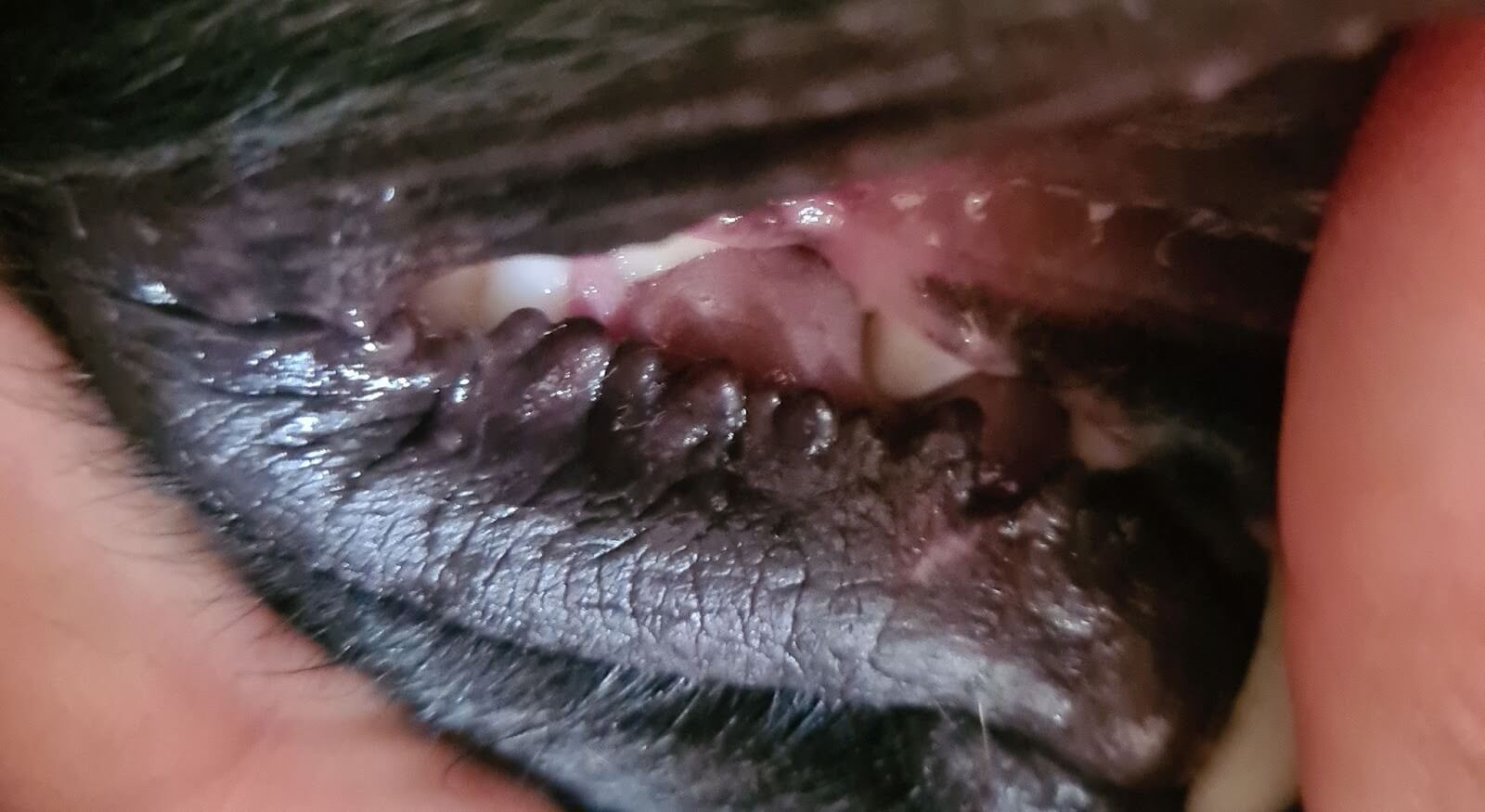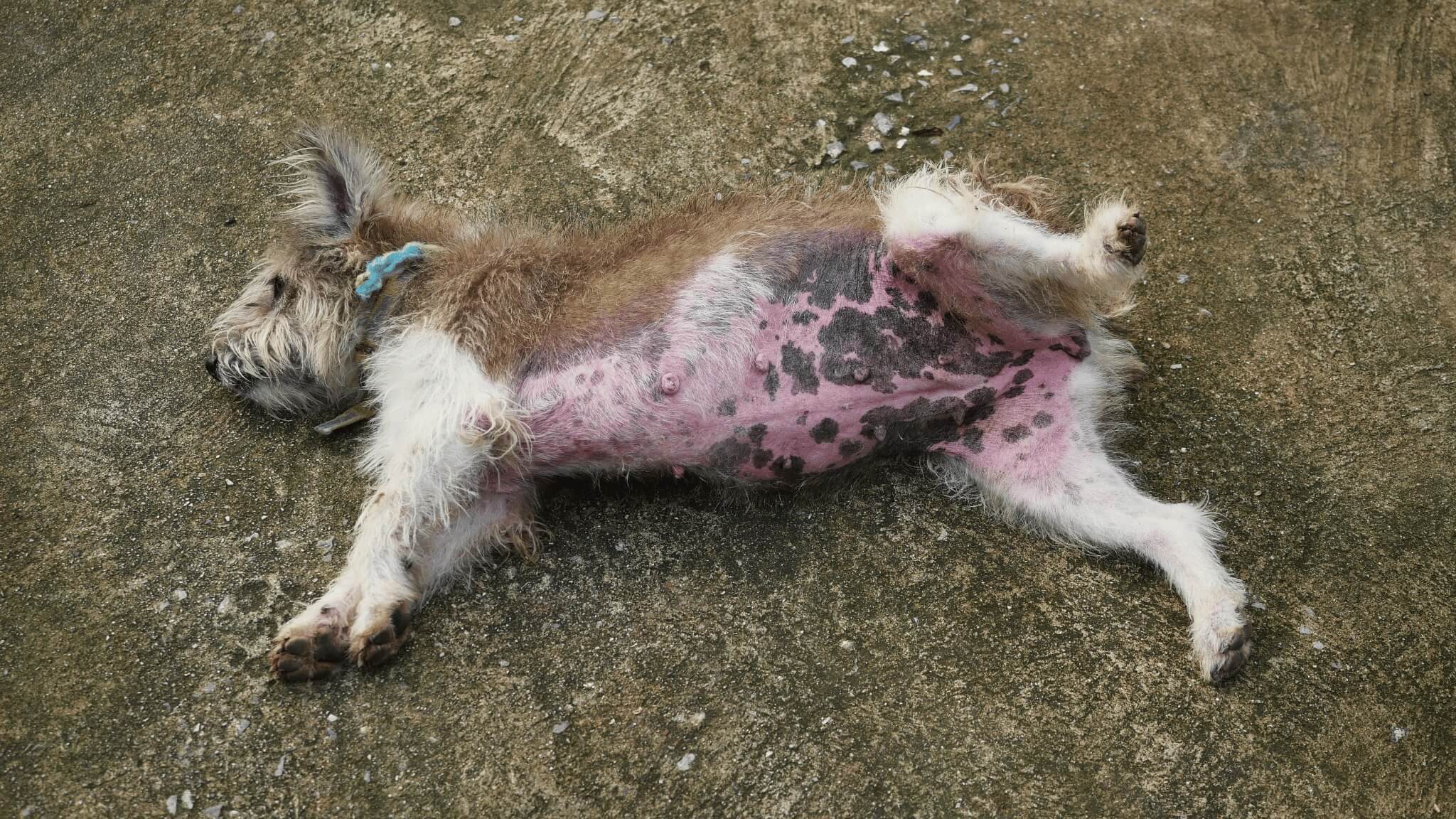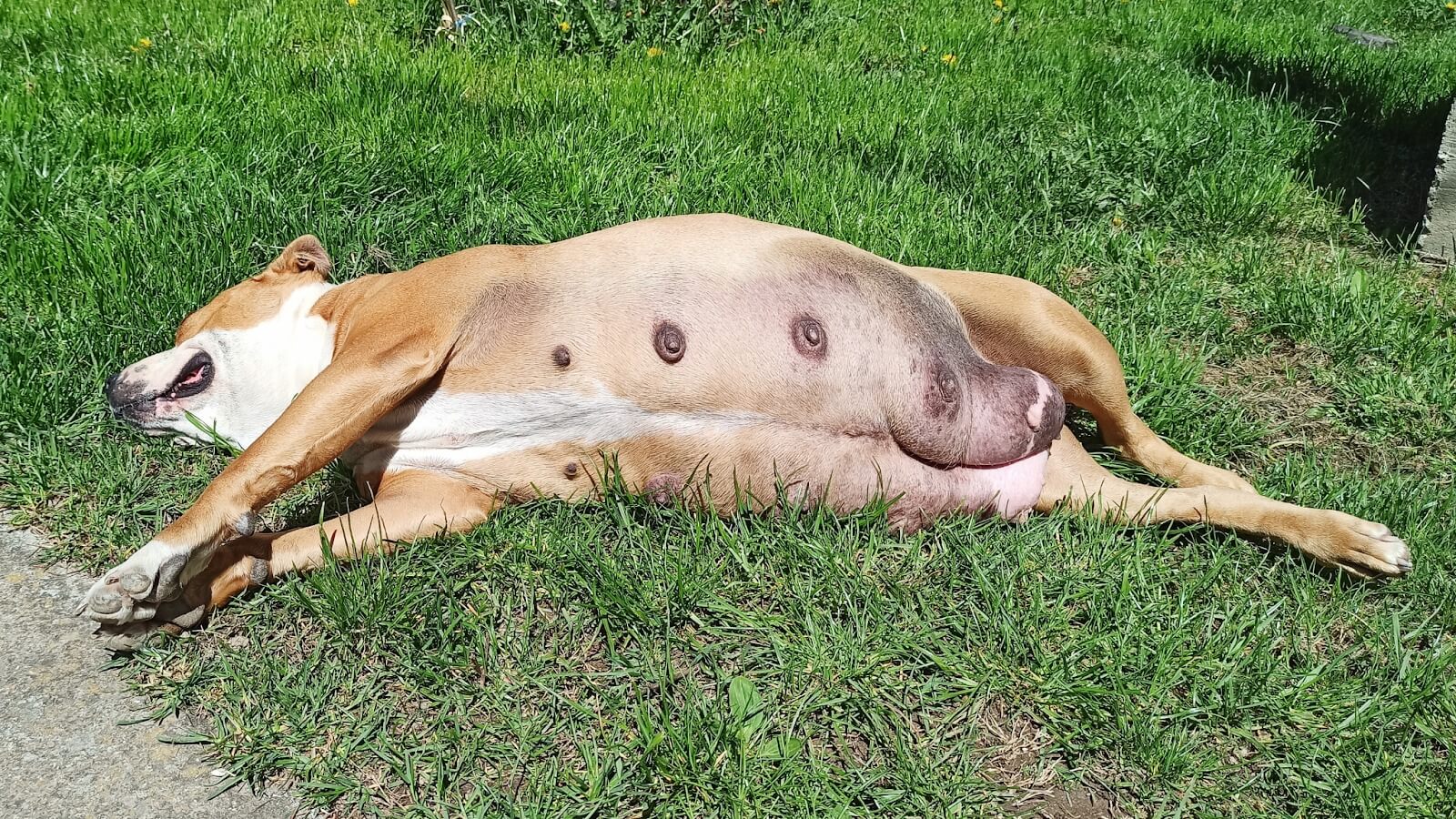Dogs get all kinds of lumps and bumps but finding one on your dog’s lips can be scary. While it can be alarming to see any unusual growths on our pets, it’s essential to know that not all spots cause alarm.
However, usually there is no need to panic if you spot a strange bump on your dog’s lip. However, it’s always important to be proactive about any changes in your dog’s health and to seek veterinary care if you have any concerns. We have consulted sources like the BSAVA Book or Canine Dermatology and Canine Anatomy to help you understand better what bumps on your dogs’ lips mean and what you can do to be on the safe side together with your dog.
So, What Are The Bumps on a Dog’s Lips?
Dogs naturally have a serrated edge of bumps on their inner lips called rugal folds. This is a normal part of their anatomy, however they may also have other lumps and growths such as oral warts, tumors, insect bites, abscesses, or trauma.
While the warts may look unsightly and painful, they pose no harm to the victim. However, some bumps may be more serious, such as skin cancer or an abscess caused by an infection.
As harmless as they may be, it’s always better to err on caution and have a professional evaluation. By working together with our veterinarians, we can help ensure our dogs stay healthy and happy for years to come.
All dogs are prone to papillomavirus. However, young and old dogs and dogs with compromised immune systems tend to develop warts and other disorders of the mouth. Two types of canine papilloma are recognized to cause several cutaneous lesions in dogs.
What Causes Bumps On Dogs Lips?
An estimated 25% of all dogs get cancer at some point in their lifetime, and the skin is the most affected organ. Bumps on a dog’s lips are caused by the following:
1. Ruga or Rugal folds
Ruga or Rugal folds are the wrinkles or folds on a dog’s lips. These folds are a natural part of a dog’s anatomy and can vary in size and prominence depending on the breed and individual dog.
The purpose of these folds is to allow for greater flexibility in the lips, which helps dogs to grasp better and hold onto objects, such as toys or food. Additionally, the folds can help to prevent water and other substances from getting into the dog’s mouth while drinking or eating.
While rugal folds are a normal part of a dog’s anatomy, they can sometimes become inflamed or infected. This can happen if food or other debris becomes trapped in the folds, leading to irritation and potential infection. It is essential to regularly clean and inspect your dog’s lips to ensure they are healthy and free from any signs of infection or inflammation.
2. Oral Papilloma (Warts)
If you notice small, pink, cauliflower-like bumps on your dog’s lips, it could be canine oral papillomatosis, also known as warts. They come from the dog version of the HPV virus that gives human’s warts. Oral papillomas or warts are usually found on the lips, gums, tongue, and roof of the mouth and usually don’t need any treatment.
Dogs with a compromised immune system, older dogs, or dogs that come into close contact with other dogs with warts are most at risk of contracting the papillomavirus.
However, if the warts are causing discomfort to your dog or are affecting their ability to eat or drink, you may want to consider treatment options. What’s more, when a dog has recovered from CPV, they are considered resistant to reinfection.
It’s important to note that oral papillomas are contagious to other dogs, so it’s best to isolate your dog from other dogs until the warts have healed.
3. Foreign Objects
Dogs are adventurous, and they explore using their mouths and noses. Unfortunately, this can sometimes lead to foreign objects getting stuck in their lips, causing bumps, swelling, inflammation and irritation.
Everyday foreign objects that can cause bumps on a dog’s lips include splinters from sticks, thorns, and burrs.
If you notice a bump on your dog’s lips, it’s essential to scrutinize the area. Look for signs of a foreign object, such as a splinter or thorn. If you can see the thing, try to remove it only if the operation is possible without risking further damage to the mouth.
In some cases, foreign objects can become deeply embedded in the lips, making them difficult to remove. If this is the case, your vet may need to sedate your dog to remove the object safely.
4. Insect Bites
Insects like mosquitoes, ants, bees, and wasps can bite or sting your dog’s lips, causing lumps, swelling, and allergic reactions you may see on the lips.
Insect bites and fleas can also cause swelling and redness at the bite site, which can be mistaken for a wart. However, this will only last between 12 to 24 hours and will go away on their own. Studies show that dog-appropriate antihistamines usually work pretty well.
Diphenhydramine and hydroxyzine were the most used antihistamines and were the most effective. You can apply a cold compress to the affected area to reduce swelling. You can also give your dog antihistamines to help relieve any itching or discomfort.
Preventing insect bites on your dog’s lips can be difficult, but you can keep them indoors during peak mosquito or bee activity times. You can also use insect repellents that are safe for dogs to help keep them protected.
5. Blackheads and Acne
Blackheads and acne are common skin conditions in dogs. Blackheads, also known as comedones, are small bumps that form when hair follicles become clogged with dead skin cells, dirt, and oil. They can appear on a dog’s lips, chin, and muzzle.
Acne, conversely, is a more severe form of blackheads that can lead to red, inflamed bumps on a dog’s skin. Hormonal imbalances, allergies, or poor hygiene can cause it.
To prevent blackheads and acne, it’s essential to keep your dog’s face clean and dry. You can use a gentle, non-irritating cleanser to remove dirt and oil from your dog’s skin. Avoid using harsh chemicals or scrubbing too hard, as this can irritate the skin and make the condition worse.
6. Oral Tumors
When it comes to lumps on a dog’s lips, oral tumors can be a concern. These tumors are primarily associated with pain and could cause drooling or your dog not willing to eat. Tumors can be benign or malignant, and it’s vital to have them checked out by a veterinarian as soon as possible.
Benign tumors are primarily common in young dogs. They are not invasive, and treating benign symptoms may require surgery, chemotherapy, or radiation.
Malignant tumors are more severe and come in three types. They appear suddenly with rapid growth and spread. Some common types of malignant tumors in dogs include:
- Melanoma: a kind of skin cancer that can occur on the lips and gums;
- Fibrosarcoma: a tumor that originates in the connective tissue of the mouth; and
- Squamous cell carcinoma: a type of cancer that can occur on the lips, gums, and tongue.
A the MSD manual clearly states that if malignancy is suspected, tissues around the tumors should also be removed to make sure there are no tumor cells left behind. Early detection and treatment can improve your dog’s prognosis and quality of life.
Diagnosis of Bumps on Dog’s Lips
When diagnosing bumps on dogs’ lips, it’s essential to take a thorough approach. We recommend starting with a physical examination of the affected area. This can help us determine the size, shape, and texture of the bump, as well as any other symptoms that may be present.
A biopsy is also required to help us identify the underlying cause of the bump. This involves taking a small tissue sample from the affected area and examining it under a microscope. This can help us determine if the spot is cancerous or non-cancerous, as well as the specific type of growth present.
Other diagnostic tests that may be recommended include blood work, X-rays, or ultrasound. These tests can help us identify any underlying health issues that may be contributing to the development of the bump, such as infections or autoimmune disorders.
Prevention Strategies
Regular grooming
Healthy diet
Avoiding irritants
Regular check-ups
Avoid kennels and public dog parks
However, if your dog has contacted the bumps before and healed from it, they are immune and cannot get infected twice.
Treatment Options
Since warts are usually asymptomatic, treatment is not prescribed until the warts become symptomatic. It is good to note that for benign tumors that do not impair the dog’s normal routine, treatment may not be necessary.
When it comes to treating symptomatic bumps on a dog’s lips, however, several options are available. Here are some of the most common treatment options:
Home Remedies
Home remedies are nonprescription therapies that are safe to administer to your pup as you are waiting for an appointment with the vet. Some home remedies that may help reduce the size and discomfort of bumps on a dog’s lips include
- Applying a warm compress to the affected area;
- Using aloe vera gel; and
- Wash the infected area with an oatmeal-based shampoo.
However, it’s important to note that home remedies should not be used as a substitute for professional veterinary care.
Medications
Bumps on a dog’s lips can be treated with medications. These may include antibiotics, antihistamines, or corticosteroids. Antibiotics treat bacterial infections, while antihistamines and corticosteroids can help reduce inflammation and itching.
Surgical Procedures
If the bump on a dog’s lip is large or causing discomfort, surgical removal may be necessary. This procedure is usually done under general anesthesia and involves cutting out the bump and surrounding tissue. Depending on the size and location of the spot, stitches may be necessary to close the wound.
When to Consult a Vet
If you notice bumps on your dog’s lips, it’s essential to monitor them closely. While some bumps may be harmless and go away independently, others may require medical attention. Here are some signs that it’s time to consult a vet:
- The bump is growing rapidly;
- The spot is bleeding or oozing;
- Your dog is in pain when you touch the bump;
- Your dog is scratching or biting at the bump excessively; and
- The bump is accompanied by other symptoms such as fever or loss of appetite.
If you notice any of these signs, it’s best to consult a vet as soon as possible. The vet can examine the bump and determine the best course of action, including biopsy or removal of the bump.
It’s important to note that not all bumps on a dog’s lips are cancerous. Many are benign and can be easily treated. However, it’s better to be safe than sorry about your furry friend’s health. So, if you have any concerns about bumps on your dog’s lips, don’t hesitate to consult a vet.
Frequently Asked Questions (FAQs)
What causes bumps to appear on a dog’s lips?
How can I tell if the bumps on my dog’s lips are papillomas?
Are bumps on a dog’s lips always signs of a health problem?
What treatment options are available for bumps on a dog’s lips?
Can I prevent my dog from developing bumps on their lips?
When should I take my dog to the vet for bumps on their lips?
Conclusion
Various factors, including contact with an infected dog, foreign objects, and insect bites, can cause bumps on a dog’s lips. While some bumps may be harmless and resolve independently, others may require medical treatment such as antibiotics or surgery.
Regular check-ups and preventative measures such as maintaining good oral hygiene and avoiding exposure to potential allergens can help reduce the likelihood of bumps on your dog’s lips.
Always monitor your dog’s health and seek professional advice if you have any concerns about their well-being.









